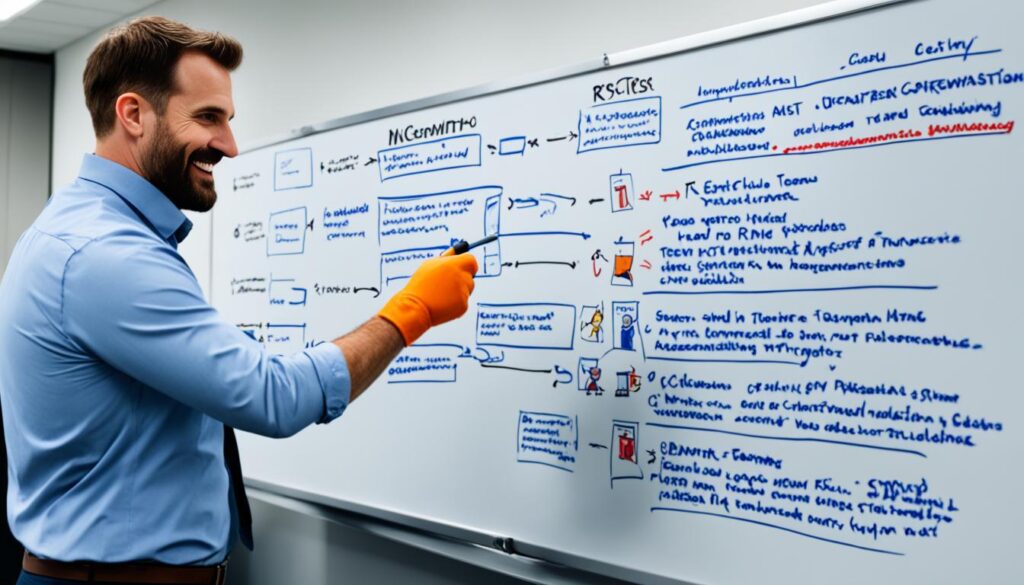In today’s digital landscape, small businesses are increasingly vulnerable to cybersecurity threats. Protecting sensitive data and mitigating risks is crucial for the survival and success of these organizations. That’s where the NIST SP800-37 Risk Management Framework comes in. As experts in the field, we understand the challenges small firms face when it comes to implementing complex frameworks. In this article, we will provide you with actionable insights and a step-by-step guide on how to apply the SP800-37 framework in your small business. By following these guidelines, you can enhance your cybersecurity posture, comply with regulations, and safeguard your operations.
Key Steps in Applying the SP800-37 Framework in Small Firms:
– Understand the NIST Risk Management Framework and its relevance to small businesses
– Familiarize yourself with the NIST Framework Core and its functions
– Categorize your information systems based on the types of data processed
– Select and implement the appropriate security controls to protect your systems and data
– Continuously assess and update your information system controls
– Monitor security controls to ensure ongoing compliance and effectiveness.
Benefits of Applying the SP800-37 Framework in Small Firms:
– Build repeatable processes for managing cybersecurity risks
– Improve your security and privacy posture
– Facilitate risk management decisions based on a systematic approach
– Meet security and privacy requirements, including compliance with regulations like FISMA.
Tips for Getting Started:
– Engage a third party for the initial risk assessment and guidance
– Start small and prioritize identified risks
– Leverage the expertise of third-party IT and security consultancies
– Use automated tools for continuous monitoring.
Applying the SP800-37 Framework in Practice:
– Protect assets by prioritizing risks
– Manage reputation by addressing cyber threats and breaches
– Safeguard intellectual property through effective controls.
By following these steps and leveraging the SP800-37 framework, small firms can enhance their cybersecurity posture, protect their operations, and comply with regulations. Take the necessary steps today to secure the future of your business.
(Note: The image alt attribute contains the keyword “Applying SP800-37 in Small Businesses” to improve SEO relevance.)
Understanding the NIST Risk Management Framework
The NIST Risk Management Framework (RMF) is a comprehensive approach that organizations can follow to effectively manage cybersecurity risks and ensure compliance with regulations. The framework, outlined in NIST SP 800-37, provides a structured process to guide organizations through six key steps, enabling them to identify, assess, and mitigate risks.
As part of the NIST RMF, organizations can achieve compliance with the Federal Information Security Management Act (FISMA) by implementing the framework’s recommended security controls. These controls, documented in standards like NIST SP 800-53/800-53a, cover various aspects of IT security, from access control to system acquisition, ensuring a robust security posture.
The NIST RMF follows a security life cycle approach, emphasizing the importance of assessing, implementing, and continuously monitoring security controls. By adopting the framework, organizations can effectively safeguard their information systems, protect sensitive data, and meet regulatory requirements.
To illustrate the relevance of the NIST RMF, let’s take a closer look at each of its six steps:
- Categorization of Information Systems: Organizations begin by categorizing their information systems based on the types of information they store and process. This step helps identify the level of protection needed for each system.
- Selection and Implementation of Security Controls: Once systems are categorized, organizations select and implement appropriate security controls to mitigate identified risks. These controls encompass a wide range of measures, including physical, technical, and administrative safeguards.
- Assessment of Security Controls: Organizations conduct periodic assessments to ensure that implemented security controls are functioning effectively and meeting their intended objectives. This step is crucial for identifying any weaknesses or vulnerabilities that need to be addressed.
- Updating Information System Controls: Based on the findings of security control assessments, organizations update their information system controls and develop action plans to remediate any identified weaknesses. This step ensures that controls remain effective in the face of evolving threats and vulnerabilities.
- Monitoring of Security Controls: Continuous monitoring is an essential aspect of the NIST RMF. Organizations regularly assess and monitor the effectiveness of their security controls to maintain ongoing compliance and swiftly respond to any changes or incidents that may arise.
- Authorization and Compliance: The final step in the NIST RMF involves granting authorization for the information system’s operation. This authorization is based on the successful implementation of the security controls and compliance with applicable regulations.
In summary, the NIST Risk Management Framework provides organizations with a structured and systematic approach to managing cybersecurity risks. By following the framework’s guidelines and incorporating the recommended security controls, organizations can enhance their security posture, achieve FISMA compliance, and protect their critical assets from potential threats.
Key Steps in the NIST Risk Management Framework
The NIST Risk Management Framework (RMF) consists of six key steps that provide organizations with a structured approach to managing cybersecurity risks. These steps help ensure the protection of sensitive information, compliance with regulations, and the overall effectiveness of security controls. Let’s explore each step in detail:
1. Categorize Information Systems
The first step in the NIST RMF is to categorize information systems based on the types of information they store and process. This step involves identifying the criticality and impact of the system, which helps determine the appropriate level of security measures needed.
2. Select and Implement Security Controls
Once the information systems are categorized, organizations need to select and implement the appropriate security controls. Security controls are measures put in place to protect the confidentiality, integrity, and availability of the system and the data it holds. These controls can include access controls, encryption, firewalls, and more.
3. Assess Security Controls
After the security controls are implemented, it’s essential to assess their effectiveness. This step involves evaluating whether the controls are implemented correctly and are providing the intended level of protection. Organizations may conduct vulnerability assessments, penetration testing, and other evaluation methods to assess the security controls.
4. Update Information System Controls
Based on the assessment findings, organizations need to update their information system controls. This step involves addressing any identified weaknesses or vulnerabilities and implementing improvements to enhance the security posture. Regular updates and maintenance of security controls are crucial to adapt to evolving threats and ensure ongoing protection.
5. Monitor Security Controls
Continuous monitoring is a vital step in the NIST RMF to ensure ongoing compliance and effectiveness of security controls. Organizations need to establish processes and systems for detecting, analyzing, and responding to security incidents. This step involves regularly monitoring security controls, reviewing audit logs, and conducting security assessments to identify and mitigate any new risks.
6. Assess Security Controls
Lastly, organizations need to assess the effectiveness of their security controls periodically. The assessment helps identify any gaps, vulnerabilities, or changes in the risk landscape that may require adjustments to the security controls. This step ensures that the security measures remain up-to-date and aligned with the organization’s risk management objectives.
By following these key steps in the NIST RMF, organizations can establish a robust cybersecurity risk management process. It enables them to protect sensitive information, maintain compliance, and adapt to evolving threats in an increasingly digital landscape.
Tips for Getting Started with the NIST Risk Management Framework
Getting started with the NIST Risk Management Framework (RMF) can be overwhelming, especially for small businesses. However, with the right approach and guidance, it can be a manageable process that helps enhance your organization’s cybersecurity posture. Here are some tips to get you started:
- Engage a third party for the initial risk assessment: To effectively implement the NIST RMF, it is beneficial to involve a knowledgeable third-party partner who can conduct a comprehensive risk assessment. Their expertise will ensure a thorough understanding of your organization’s specific cybersecurity risks and help you make informed decisions throughout the implementation process.
- Implement the framework in stages: The NIST RMF encompasses multiple steps, including categorizing information systems, selecting security controls, implementing those controls, assessing their effectiveness, and continuously monitoring them. Rather than trying to tackle everything at once, it is recommended to start small and prioritize the identified risks. Focus on implementing the most critical security controls first before moving on to others.
- Leverage third-party expertise: Small businesses often have limited internal resources and expertise in cybersecurity. Therefore, it is essential to leverage the knowledge and experience of third-party IT and security consultancies when needed. These experts can provide valuable guidance and support throughout the implementation of the NIST RMF, ensuring that you follow best practices and meet compliance requirements.
- Use automated tools for continuous monitoring: Effective cybersecurity requires continuous monitoring of security controls. Implementing automated tools can greatly streamline this process, providing real-time visibility into your organization’s security posture and alerting you to any potential threats or vulnerabilities. Automated tools can also help track and document compliance with the NIST RMF requirements, saving time and effort.
By following these tips, you can effectively navigate the complexities of the NIST RMF and establish a robust cybersecurity framework for your organization. Remember, cybersecurity is an ongoing process, and continuous monitoring and improvement are key to maintaining a strong security posture.
Understanding the NIST Framework Core

The NIST Framework Core serves as the foundation of the risk management framework, providing organizations with a structured approach to managing cybersecurity risks. It consists of five concurrent and continuous functions:
- Identify: This function involves developing an understanding of the organization’s cybersecurity risk management priorities and establishing a baseline to manage cybersecurity risks effectively.
- Protect: The protect function focuses on implementing safeguards to ensure the delivery of critical services and protect sensitive information from unauthorized access or compromise.
- Detect: This function emphasizes the establishment and implementation of activities to identify potential cybersecurity events promptly.
- Respond: The respond function aims to develop and implement an effective response to detected cybersecurity incidents, minimizing their impact and restoring normal operations swiftly.
- Recover: This function focuses on planning and implementing activities to restore services and capabilities that were breached, impacted, or disrupted during a cybersecurity incident.
These functions provide a high-level view of an organization’s management lifecycle of cybersecurity risk. They work together to create a comprehensive framework that enables organizations to address cybersecurity risks in a systematic and efficient manner.
The NIST Framework Core also includes categories and subcategories that further align with these functions, enabling organizations to better organize and prioritize their cybersecurity activities. Additionally, the core framework incorporates informative references to existing standards and guidelines for each subcategory, allowing organizations to leverage established best practices in their risk management efforts.
| Framework Function | Key Activities | Information References |
|---|---|---|
| Identify | Establish risk management priorities, develop an understanding of cybersecurity risks, and create baseline architectures. | Informative Reference 1 |
| Protect | Implement safeguards to ensure the delivery of critical services and protect sensitive information. | Informative Reference 2 |
| Detect | Establish activities to identify potential cybersecurity events, promptly detect incidents, and raise awareness. | Informative Reference 3 |
| Respond | Develop and implement response processes to address detected cybersecurity incidents and minimize their impact. | Informative Reference 4 |
| Recover | Plan and implement activities to restore services and capabilities impacted by cybersecurity incidents. | Informative Reference 5 |
Leveraging Framework Profiles for Customization
At our organization, we understand that cybersecurity is not a one-size-fits-all solution. That’s why we leverage framework profiles to customize the risk management framework according to the unique needs and risk assessments of our clients. Framework profiles represent the desired cybersecurity outcomes and provide a roadmap to compare the current state of an organization’s cybersecurity posture with the target state.
By creating a current profile that reflects the organization’s existing cybersecurity measures and a target profile that outlines the desired cybersecurity goals, we can identify the gaps and prioritize the necessary controls. This allows organizations to measure their progress and make informed decisions on allocating resources for risk management and cybersecurity initiatives.
Benefits of Framework Profiles
Customizing the risk management framework through framework profiles offers several key advantages:
- Tailored Approach: Framework profiles enable organizations to tailor their risk management strategies based on their specific business needs and risk assessments.
- Clear Goals: Clear target profiles provide organizations with a clear vision of their desired cybersecurity outcomes, facilitating goal-setting and strategic planning.
- Efficient Resource Allocation: By prioritizing controls based on the identified gaps between the current and target profiles, organizations can allocate their resources more efficiently and effectively.
- Measurable Progress: Framework profiles allow organizations to measure their progress towards achieving their target profile, enabling them to track their cybersecurity improvements over time.
Through framework profiles, we help our clients navigate the complexities of risk management customization and ensure that their cybersecurity efforts align with their unique business requirements and objectives.
Our team of experts has extensive experience in developing framework profiles and guiding organizations towards achieving their desired cybersecurity outcomes. We understand that every organization has its own set of challenges and priorities, and we are committed to providing customized risk management solutions that address these specific needs. With our expertise, organizations can take control of their cybersecurity posture and effectively mitigate risks.
Understanding Framework Implementation Tiers
In the NIST Risk Management Framework, framework implementation tiers provide valuable insight into an organization’s cybersecurity practices and maturity levels. These tiers help organizations understand their current security posture, prioritize improvements, and effectively communicate their cybersecurity practices to stakeholders.
Framework implementation tiers range from Tier 1 to Tier 4, encompassing different levels of implementation and security maturity. Here is an overview of each tier:
- Tier 1 – Partial Implementation: Organizations in this tier have only limited awareness of their risk management capabilities. They may have some basic security controls in place but lack a comprehensive and strategic approach to cybersecurity.
- Tier 2 – Risk-Informed: Organizations in Tier 2 understand their risk management responsibilities and have established some formalized processes for managing risks. However, these organizations often have inconsistent implementation and limited integration of security practices.
- Tier 3 – Repeatable: Tier 3 organizations have defined and documented their risk management processes and maintain a certain level of consistency in implementing security controls. While these organizations have made significant progress, there is still room for improvement in terms of fully institutionalizing risk management practices.
- Tier 4 – Adaptive and Risk-Informed: Organizations in Tier 4 have fully operationalized risk management practices and demonstrate an adaptive and risk-informed approach to cybersecurity. These organizations continually monitor their systems, adapt controls based on the changing threat landscape, and integrate cybersecurity into their overall business strategy.
Understanding the framework implementation tiers allows organizations to gauge their current security posture, identify gaps, and prioritize improvements accordingly. By striving for higher tiers, organizations can enhance their cybersecurity practices, establish a strong security culture, and effectively manage risks.
Note: The image above illustrates the different framework implementation tiers visually, providing a helpful reference for understanding the journey towards enhanced cybersecurity practices.
The Benefits of Using the NIST Risk Management Framework
When it comes to cybersecurity risk management, organizations can greatly benefit from implementing the NIST Risk Management Framework (RMF). This framework offers a comprehensive approach that helps organizations build repeatable processes, improve security and privacy postures, facilitate risk management decisions, meet security and privacy requirements, and achieve compliance with regulations such as the Federal Information Security Management Act (FISMA).
One of the key advantages of using the NIST RMF is the ability to establish standardized and consistent processes for managing cybersecurity risks. By following the framework’s guidelines, organizations can ensure that risk management practices are implemented in a systematic and effective manner. This not only enhances the organization’s ability to identify and mitigate risks promptly but also fosters a culture of continuous improvement in cybersecurity.
Implementing the NIST RMF also allows organizations to improve their overall security and privacy posture. By following the framework’s steps and implementing the recommended security controls, organizations can enhance their ability to protect sensitive data, systems, and assets. This proactive approach helps mitigate vulnerabilities, reduce the likelihood of successful cyberattacks, and safeguard critical information.
Risk management decisions become more streamlined and informed through the adoption of the NIST RMF. The framework provides organizations with a structured process for identifying, assessing, and prioritizing risks, enabling them to make informed decisions about resource allocation and risk mitigation strategies. This approach ensures that cybersecurity efforts align with business objectives and support the organization’s overall risk management strategy.
An essential benefit of implementing the NIST RMF is the ability to meet security and privacy requirements. The framework guides organizations in understanding and implementing the necessary security controls and policies to ensure compliance with relevant regulations and standards. Meeting these requirements not only fosters trust with customers, partners, and stakeholders but also prevents potential legal and financial consequences associated with non-compliance.
Overall, the NIST Risk Management Framework offers numerous benefits that organizations can leverage to enhance their cybersecurity practices. By adopting this framework, organizations can establish a robust risk management process, improve security and privacy postures, make informed risk management decisions, meet security and privacy requirements, and achieve compliance. With the increasing threat landscape and cybersecurity risks, the NIST RMF provides a reliable and proven approach to safeguarding critical assets and maintaining a resilient cybersecurity posture.
The NIST Risk Management Framework in Practice

When it comes to implementing the NIST Risk Management Framework (RMF), practical examples demonstrate its effectiveness in various areas of cybersecurity. By applying the framework, organizations can protect their assets, manage their reputation, and safeguard their intellectual property (IP).
Asset Protection: A key aspect of the NIST RMF is prioritizing risks to protect valuable assets. This involves identifying critical assets and determining the potential impact of their compromise. By understanding the value and sensitivity of their assets, organizations can allocate resources effectively to implement appropriate security controls.
Reputation Management: Addressing cyber threats and breaches is essential for managing reputation. The NIST RMF provides a structured approach to assess risks and mitigate vulnerabilities, reducing the likelihood of security incidents that can damage an organization’s reputation. By prioritizing reputation management within the framework, organizations can build trust with stakeholders.
IP Protection: Intellectual property is a valuable asset for many organizations. The NIST RMF helps protect IP by establishing effective controls. These controls encompass access management, encryption, secure coding practices, and more. By implementing and continually monitoring these controls, organizations can safeguard their IP from unauthorized access or exploitation.
The NIST RMF offers a comprehensive and structured approach to identify, assess, and mitigate risks. By incorporating asset protection, reputation management, and IP protection, organizations can enhance their security posture and minimize the potential impacts of cyber threats.
Below is an example table illustrating the various elements of implementing the NIST RMF in practice:
| Key Area | Actions |
|---|---|
| Asset Protection | 1. Identify critical assets 2. Assess potential risks 3. Implement appropriate security controls |
| Reputation Management | 1. Address cyber threats and breaches 2. Prioritize security incident response 3. Establish incident management protocols |
| IP Protection | 1. Implement access controls 2. Utilize encryption for sensitive data 3. Employ secure coding practices |
The Role of NIST in Cybersecurity Standards
In the field of cybersecurity, the National Institute of Standards and Technology (NIST) holds a significant position. NIST plays a crucial role in developing cybersecurity standards and guidelines that help organizations establish robust security practices. One of the notable contributions of NIST is the creation of the NIST Risk Management Framework (RMF), which serves as a comprehensive approach to managing cybersecurity risks.
NIST’s mission is to promote innovation and industrial competitiveness by advancing measurement science, standards, and technology. Since 1972, NIST has been actively involved in cybersecurity research and guidance development for federal agencies, private sector organizations, and academia.
The NIST Cybersecurity Framework, which includes the NIST RMF, provides practical guidance on how organizations can safeguard their systems, data, and operations from cyber threats. By aligning with NIST cybersecurity standards, organizations can enhance their security posture and effectively manage cybersecurity risks.
One important piece of legislation related to NIST’s role in cybersecurity is the Federal Information Security Modernization Act (FISMA). FISMA requires federal agencies to implement robust cybersecurity programs and comply with NIST cybersecurity standards. This ensures that federal information systems and data are adequately protected from cyber threats.
Benefits of NIST Cybersecurity Standards:
- Better Security: Following NIST cybersecurity standards helps organizations establish strong security practices, protecting sensitive data and systems from unauthorized access and cyber attacks.
- Compliance: Adhering to NIST standards helps organizations meet regulatory requirements, such as FISMA compliance, enhancing their credibility and demonstrating commitment to cybersecurity.
- Improved Risk Management: NIST standards provide a structured framework for identifying, assessing, and mitigating cybersecurity risks, enabling organizations to make informed risk management decisions.
- Industry Recognition: Adhering to NIST standards can enhance an organization’s reputation and trustworthiness within the industry, as they demonstrate a commitment to following best practices and maintaining high-security standards.
Organizations that incorporate NIST’s cybersecurity standards into their operations benefit from the expertise and research-driven guidance of a trusted authority in the field of cybersecurity. By following these standards, organizations can strengthen their cybersecurity defenses and effectively protect their digital assets.
Image:
| NIST Cybersecurity Standards | Key Features |
|---|---|
| NIST SP 800-53 | Provides a comprehensive catalog of security controls for federal information systems and organizations. |
| NIST SP 800-171 | Addresses security requirements for protecting U.S. defense information and Controlled Unclassified Information (CUI). |
| NIST SP 800-37 | Outlines the Risk Management Framework (RMF) and provides guidance on managing cybersecurity risks. |
| NIST SP 800-161 | Focuses on supply chain risk management and provides guidelines for mitigating cyber threats originating from supply chains. |
Applying the NIST Risk Management Framework in Different Industries and Sectors
The NIST Risk Management Framework (RMF), initially designed for federal agencies, is highly applicable to various industries and sectors. Organizations across the board, including state agencies, local government bodies, and private sector companies, have adopted the framework to enhance their cybersecurity posture and achieve compliance with industry-specific regulations.
By implementing the NIST RMF, organizations can effectively manage and mitigate cybersecurity risks, ensuring the protection of critical assets, sensitive data, and valuable intellectual property. The framework’s flexible and customizable approach allows businesses to tailor their risk management strategies to align with their unique industry requirements.
The benefits of adopting the NIST RMF extend beyond regulatory compliance. Organizations gain a deeper understanding of their cyber risks and develop comprehensive strategies to safeguard their operations and reputation. They can proactively identify vulnerabilities, implement security controls, and enhance incident response capabilities, thereby minimizing the potential impact of cyber threats.
Adopting the NIST RMF is an investment in security that demonstrates a commitment to protecting client data, maintaining business continuity, and building trust with stakeholders. Compliance with the framework not only helps organizations avoid costly breaches but also positions them as responsible and trustworthy partners in their respective industry landscapes.
Examples of NIST RMF Adoption across Industries
Let’s explore how the NIST RMF has been successfully applied in different industries:
| Industry | NIST RMF Adoption | Benefits |
|---|---|---|
| Healthcare |
|
|
| Financial Services |
|
|
| Energy |
|
|
| Education |
|
|
These are just a few examples of how the NIST RMF can be tailored and implemented to address industry-specific cybersecurity challenges. Regardless of the industry, the framework provides organizations with a structured and comprehensive approach to managing cyber risks.
Conclusion
The NIST Risk Management Framework (RMF) offers organizations a comprehensive and flexible approach to managing cybersecurity risks. By following the structured process outlined in the framework, organizations can effectively identify, assess, and mitigate risks, ensuring the protection of their assets, compliance with regulations, and a strong security posture.
By leveraging the core functions of the NIST RMF, organizations can enhance their security practices. The five concurrent and continuous functions of Identify, Protect, Detect, Respond, and Recover provide a framework for managing cybersecurity risks throughout the entire lifecycle of an organization’s operations. This approach allows for targeted and proactive security measures, better protecting people, operations, and assets.
Implementing the NIST RMF is crucial in today’s evolving threat landscape. By prioritizing cybersecurity risks and using the framework’s steps and functions, organizations can establish a solid foundation for managing risks effectively. Continuous monitoring, regular assessments, and updates to information system controls are essential for maintaining ongoing compliance and addressing emerging threats.
In conclusion, the NIST RMF empowers organizations to take a proactive and risk-based approach to cybersecurity. By embracing the framework’s principles, organizations can enhance their security practices, mitigate risks, and build a robust security posture that protects their valuable assets and stakeholders.







